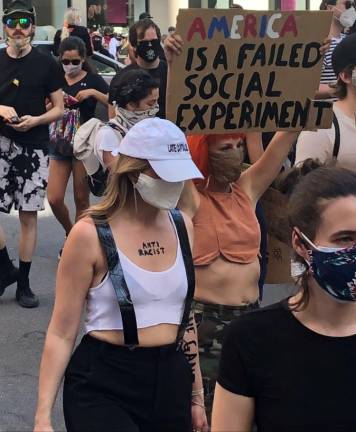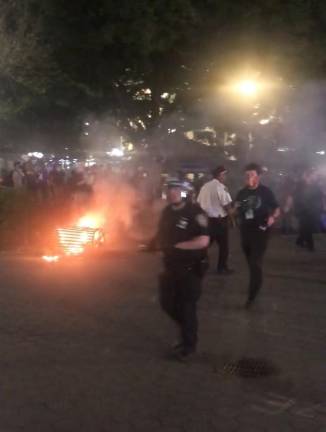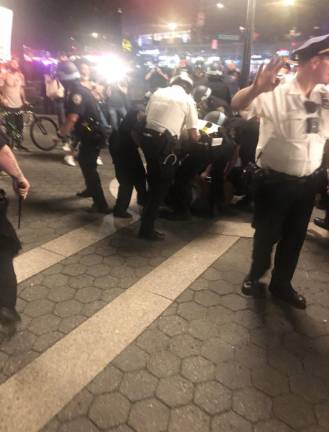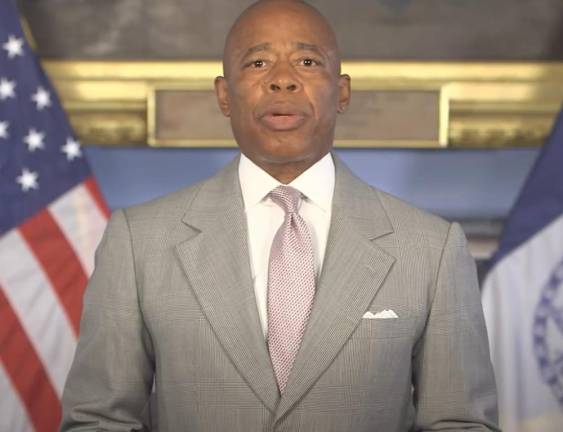NYPD Agrees on New Tiered Approach to Policing Protests As Part of BLM Settlement
Announced in coordination with Mayor Eric Adams, the new graduated system of de-escalation comes as part of a settlement levied against the city for its response to the 2020 Black Lives Matter protests. The Police Benevolent Association, a union representing rank-and-file cops, notably condemned the agreement.




If ultimately signed off on by a judge, a new settlement will codify a mandatory de-escalation system for the NYPD when it comes to policing protests. The new tiered approach is the fruit of a lawsuit brought by NY Attorney General Letitia James–in conjunction with the New York Civil Liberties Union and the Legal Aid Society–on behalf of Black Lives Matter protestors.
Essentially, the updated rules will implement a four-step graduated process that the NYPD would follow depending on the course of protest events.
The first tier, for when protests remain at a low register, would only allow police to enforce traffic laws and the like. Community affairs officers would be permitted to “liaison” with protest leaders.
The second tier would kick into gear if police believe illegal actions are about to occur, or if critical infrastructure (defined by the settlement as “highways, bridges and tunnels, railways, subways, schools, hospitals,” etc.) is possibly about to be blocked. At this point, additional officers–including counterterrorism or riot gear units–are allowed to be stationed near protestors.
The next tier comes when laws are genuinely broken. At this point, officers may be “deployed as necessary,” according to the mayor’s office. In other words, it appears that individual arrests may be made.
The final tier kicks into gear when protestors begin completely blocking “sensitive locations,” defined by the settlement as buildings such as police precincts, courthouses, or medical clinics. The settlement notes that police may attempt to completely end the protest at this tier if further de-escalation doesn’t appear “viable.” However, they must inform protestors of other viable protest routes “if feasible,” issue dispersal orders, and identify exit routes.
The settlement will also reportedly ban infamous practices such as “kettling,” whereby officers cut off protestors from exit routes in order to conduct mass arrests and end up causing general pandemonium. Helicopters are likewise no longer allowed to fly near protestors to intimidate them.
The settlement’s general principles conclude that “no individual will be arrested on account of their exercise of their lawful First Amendment speech.”
More specifically, the document claims that “City Defendants” have acknowledged that “First Amendment-protected activities serve important societal functions, including promoting transparency in government affairs, ensuring accountability of public officials; and encouraging community feedback, whether critical or laudatory, that ultimately reduces tension and fosters a sense of openness and trust between government officials and the public.”
Mayor Eric Adams noted that he believed the settlement would “build consensus.”
“The right to peaceful protest is a fundamental part of American freedom, and the right to public safety is essential for our city to function — balancing these two important rights is one of this administration’s core missions. I spent my career fighting for police reform and accountability, and now as mayor, our administration is committed to improving our policies to keep New Yorkers safe and protect their civil liberties,” he added.
NYPD Commissioner Edward Caban struck a similarly equivocal tone, proclaiming that the 2020 Black Lives Matter protests “presented many unique challenges for officers, who did their best to protect people’s rights to peaceful expression while addressing acts of lawlessness. Now, the NYPD has re-envisioned its policies for policing protests to deal with these unique scenarios.”
An unsurprising critic of the settlement has emerged: the Police Benevolent Association, which represents an overwhelming chunk of the NYPD’s rank-and-file. Patrick Hendry, the union’s leader, declared that “we have serious concerns about [the settlement’s] impact on the safety of police officers and all New Yorkers in future situations involving coordinated violent actions.”
The Detectives’ Endowment Association and the Sergeants Benevolent Association reportedly worked on the language of the settlement, and ultimately signed off on it.